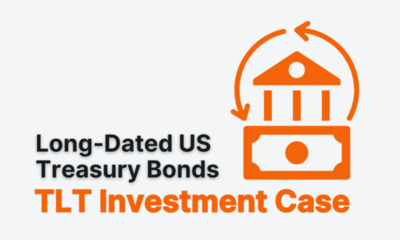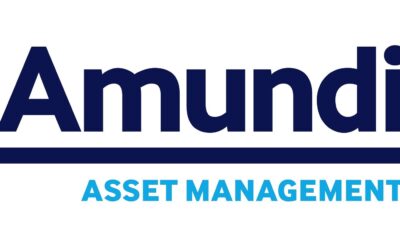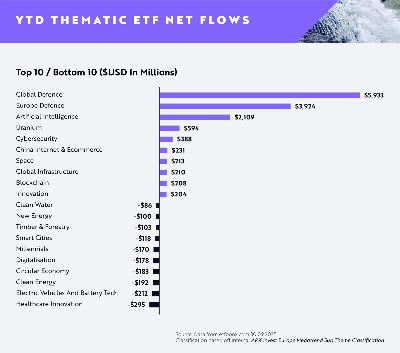Lyxor ETF lanserar fem tematiska ETF:er som erbjuder unik tillgång till investeringsteman och megatrender som omformar industrier över hela världen. De olika teman som berörs inkluderar tillväxten inom digital ekonomi och disruptiv teknologi, urban förändring med framtida mobilitet och smarta städer, samt konsumtionsbeteenden från ”millennials”. Dessa nya teman öppnar upp för investerare att fånga investeringsmöjligheter som ser över traditionella sektorer och marknadsviktade fonder.
Med index beräknade av MSCI och anpassningar till dessa utvecklade tillsammans med Lyxor, tar var och en av dessa ETF:er ett stort steg framåt för fondindustrin idag.
De tematiska indexen använder en uppsättning nyckelord som innefattar temarelaterade produkter, tjänster och koncept – screenade med hjälp av naturlig språkbearbetning och den senaste datavetenskapsteknologin – för att identifiera företag som inkluderas på ett regelbaserat sätt och på andelen intäkter från verksamheten som är kopplad till ett visst tema.
MSCI tar hjälp av världsledande och erkända experter inom området för att säkerställa att varje index’ mål och associerade underteman är optimala och uppdaterade för att på bästa sätt fånga en viss trend.
Varje index filtreras baserat på en MSCI ESG-score, med slutliga aktievikter baserade på en kombinerad poäng från tre grundläggande mätvärden. Dessa mätvärden baseras på att man exkluderar vissa affärsverksamheter (exempelvis kärnvapen och tobak) och bolag involverade i allvarliga kontroverser. Istället ser man till att ge större vikt åt bolag med en gedigen track record i form av växande intäkter, effektivt användande av kapital och där man investerar för framtiden.
Genom att kombinera transparent indexering, banbrytande datavetenskap och mänsklig insikt om trendutveckling är dessa ETF:er unika inom tematisk investering. De blandar det bästa av passiva och aktiva strategier tillsammans för att ge investerare en likvid och prisvärd tillgång till investeringsteman som driver förändring.
Arnaud Llinas, Head of Lyxor ETF & Indexing, kommenterar: “Världen förändras snabbt, vilket den nuvarande Covid-19-krisen är ett tydligt exempel på; och människor hittar nya innovationer snabbare än någonsin. Den stora mängden som jobbar hemifrån har till exempel lett till att miljoner fler människor blivit introducerade till den digitala ekonomin. Samtidigt har hälsofrågan lett till diskussioner om framtidens mobilitet och hur smarta städer kan hjälpa till att bekämpa spridningen av infektionssjukdomar. Framtiden för sektorinvesteringar ser också ut att bli annorlunda. Det är därför dessa ETF:er sätter en ny spelplan för passiva investeringar. Kanske har ETF:er till en början fungerat som enkla marknadstillträdesinstrument, men de har idag blivit en väg för investerare att få en tydlig exponering mot nya teman för vår tidsålder och vara steget före förändring. Med dessa lanseringar fortsätter vi på Lyxor vår långa tradition som en av Europas mest innovativa ETF-leverantörer.”
Stephane Mattatia, Global Head of Thematic Indexes på MSCI, tillägger: ”Det är allmänt känt att det finns ett antal megatrender som kommer att påverka den globala ekonomin och samhället i stort. MSCI:s tematiska index ger investerare verktygen för att utvärdera och mäta dessa strukturella trender via vår skalbara och flexibla metodik.”
De fem fysiskt replikerade ETF:erna är noterade på Euronext, London Stock Exchange, Xetra och Borsa Italiana med en rabatterad TER på 0,15% (återgår till 0,45% i september 2021).
|
ETF-namn
|
Indexnamn
|
Replikeringsmetod
|
Bloomberg Ticker
|
ISIN-kod
|
Total Expense Ratio (TER)*
|
|
Lyxor MSCI Smart Cities ESG Filtered (DR) UCITS ETF
|
MSCI ACWI IMI Smart Cities ESG Filtered Net Total Return Index
|
Fysisk
|
IQCY; IQCT
|
LU2023679256
|
0.45%
|
|
Lyxor MSCI Future Mobility ESG Filtered (DR) UCITS ETF
|
MSCI ACWI IMI Future Mobility ESG Filtered Net Total Return Index
|
Fysisk
|
ELCR; MOBI
|
LU2023679090
|
0.45%
|
|
Lyxor MSCI Digital Economy ESG Filtered (DR) UCITS ETF
|
MSCI ACWI IMI Digital Economy ESG Filtered Net Total Return Index
|
Fysisk
|
EBUY; DIGE
|
LU2023678878
|
0.45%
|
|
Lyxor MSCI Disruptive Technology ESG Filtered (DR) UCITS ETF
|
MSCI ACWI IMI Disruptive Technology ESG Filtered Net Total Return Index
|
Fysisk
|
UNIC; DTEC
|
LU2023678282
|
0.45%
|
|
Lyxor MSCI Millennials ESG Filtered (DR) UCITS ETF
|
MSCI ACWI IMI Millennials ESG Filtered Net Total Return Index
|
Fysisk
|
MILL; GENY
|
LU2023678449
|
0.45%
|

 Nyheter4 veckor sedan
Nyheter4 veckor sedan
 Nyheter3 veckor sedan
Nyheter3 veckor sedan
 Nyheter4 veckor sedan
Nyheter4 veckor sedan
 Nyheter4 veckor sedan
Nyheter4 veckor sedan
 Nyheter3 veckor sedan
Nyheter3 veckor sedan
 Nyheter1 vecka sedan
Nyheter1 vecka sedan
 Nyheter4 veckor sedan
Nyheter4 veckor sedan
 Nyheter3 veckor sedan
Nyheter3 veckor sedan























